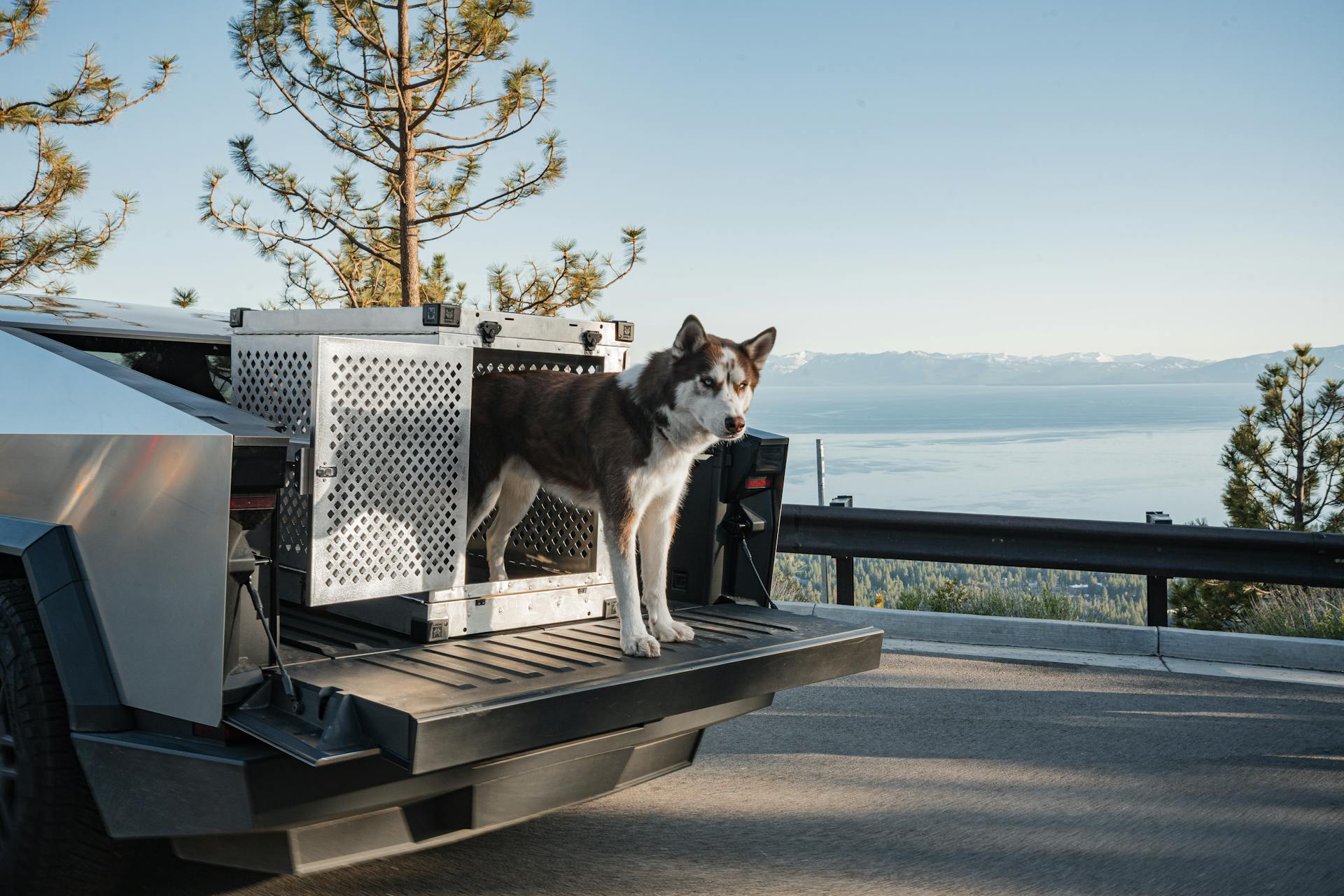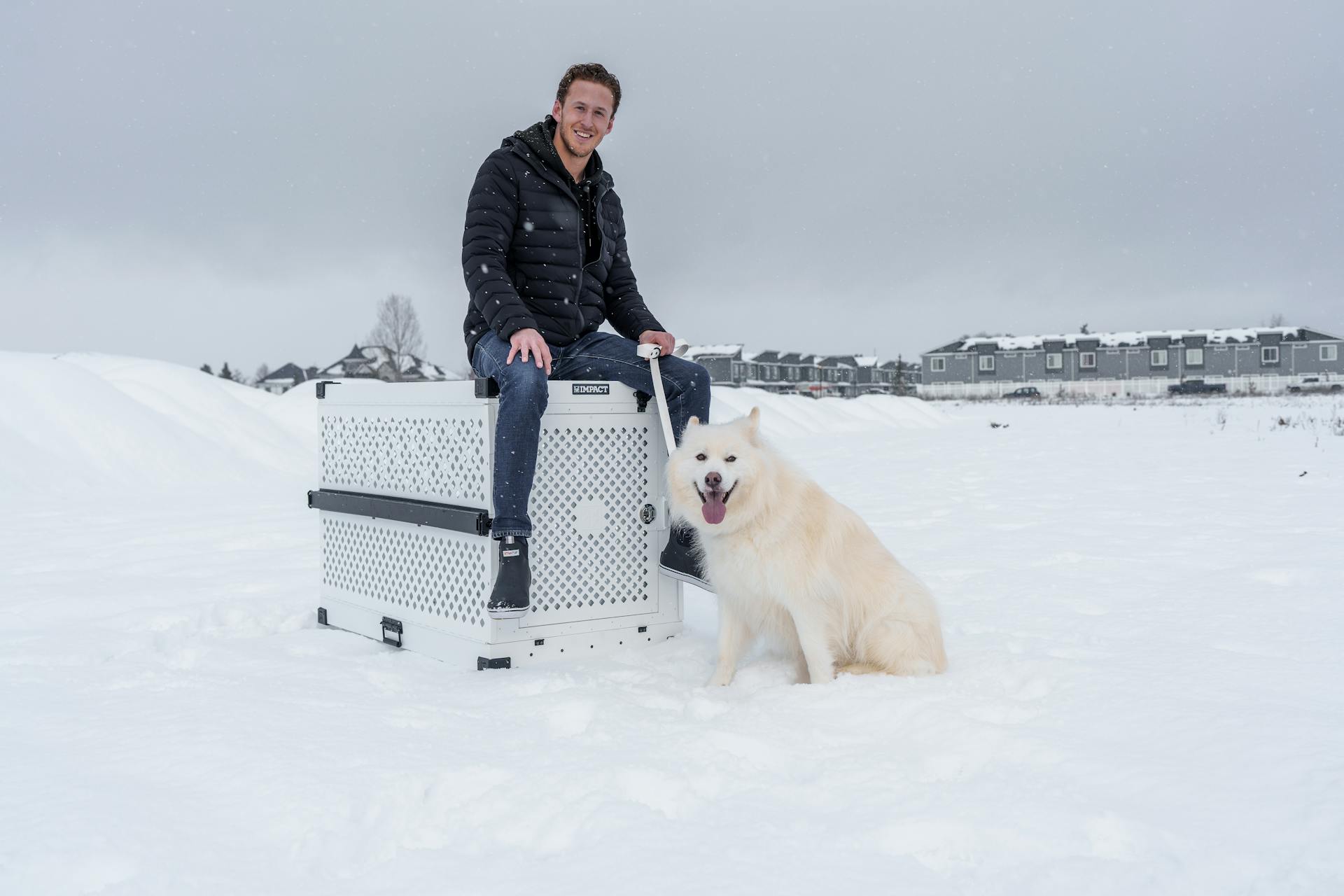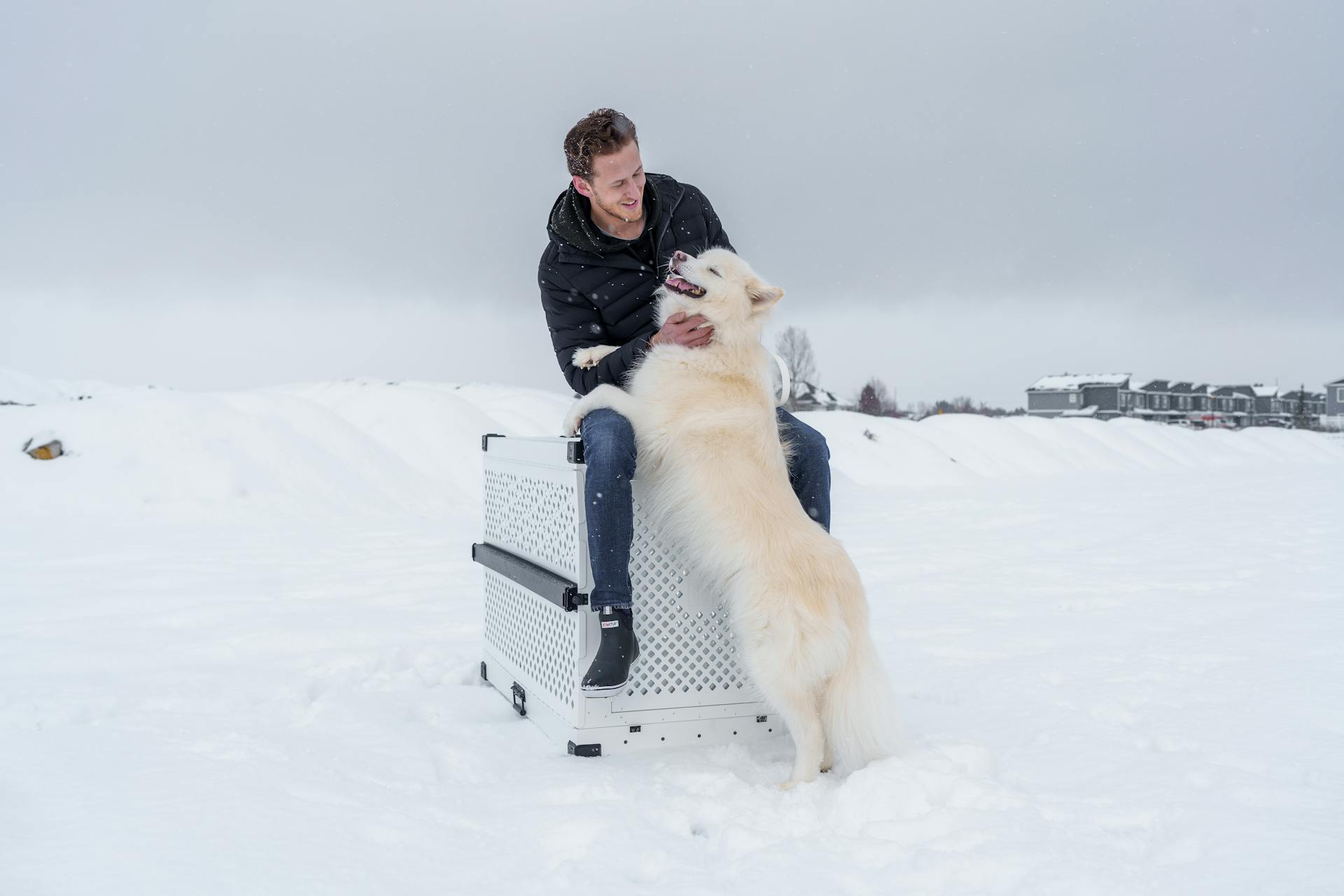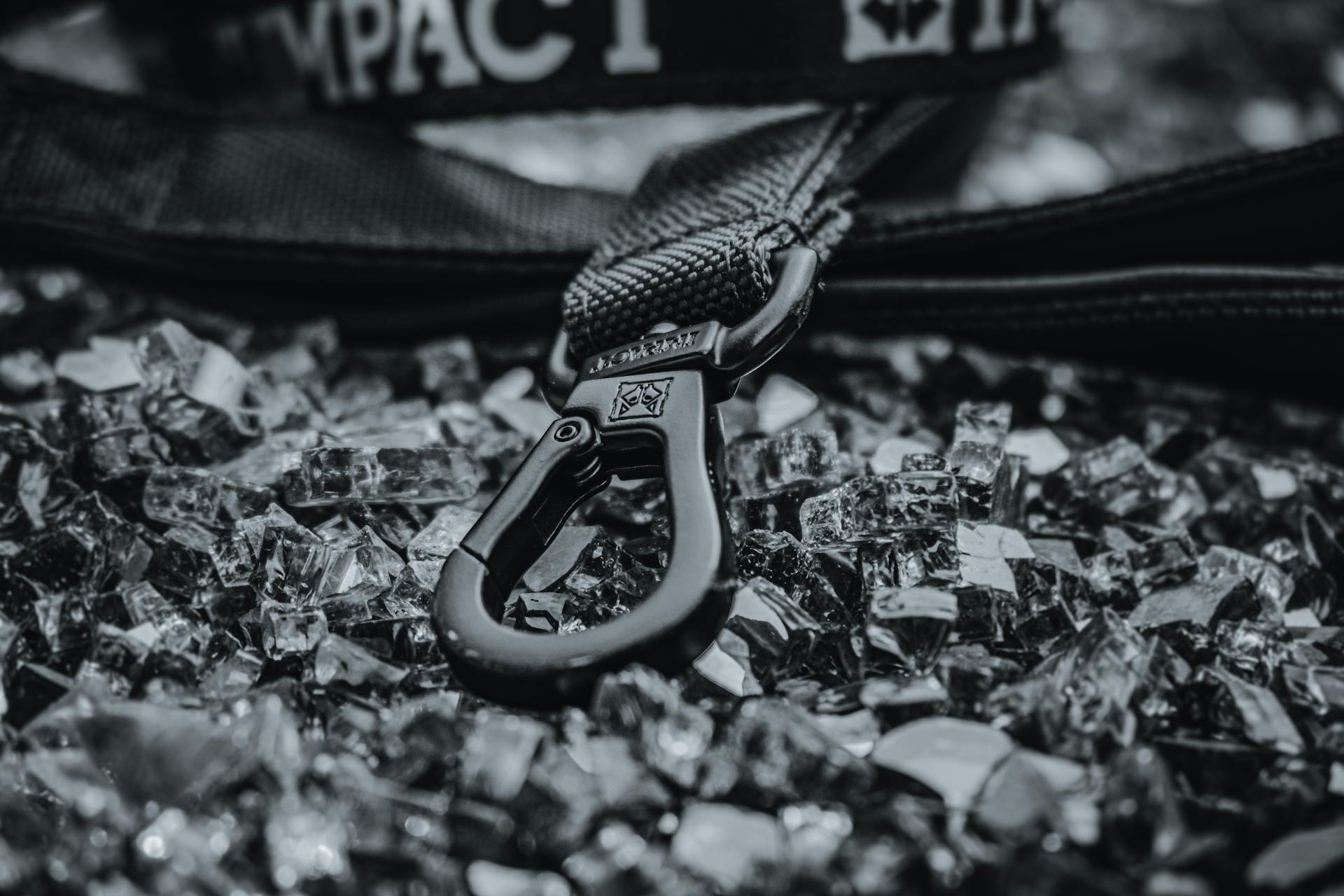
Crate training a husky requires patience and consistency.
Huskies are intelligent dogs that thrive on structure and clear boundaries, making crate training an ideal solution for their high energy levels.
A crate should be introduced gradually, starting with short periods and increasing the duration as your husky becomes more comfortable.
The crate should be large enough for your husky to stand up, turn around, and lie down comfortably, but not so large that they can use one end as a bathroom and the other as a sleeping area.
A crate is not a punishment, but rather a safe space for your husky to relax and feel secure.
Check this out: Training Puppies Not to Bite
Why Crate Train a Husky?
Crate training a Husky is a game-changer for any dog owner. With crate training, you can leave your dog at home without hesitation, knowing that nothing will be destroyed or damaged once you return.
Crate training helps teach your Husky where to be during specific time periods and limits his boundaries until he learns more about the house. This includes where to go potty and where he shouldn't go.
One of the biggest benefits of crate training is that it makes house training easier and prevents potty accidents from happening inside the house. Just remember to take your dog for a potty break before putting him in his crate.
A portable dog crate makes it easy to take your Husky on journeys with you. An escape-proof dog crate provides safety for your dog while you're away from home or when there's no one to supervise him.
You can also use a crate as a shelter for your dog when he's tired or stressed. This will help him feel more secure and calm.
Here are some reasons why crate training is a great idea:
- Reduces behavior problems like barking and digging
- Provides a sense of security and calm for your dog
- Helps your dog feel like he's with you all the time, even when he's in his crate
- Creates a personal den for your dog to take naps and relax
- Prevents accidents and damage to your home
Preparation and Setup
Before you start crate training your Husky, it's essential to prepare and set up a safe and comfortable environment for your dog. Never force your dog to get inside a crate or leave them for a longer period of time, as this can be stressful and even damaging for your dog's well-being.
To determine the right size of the crate, consider your Husky's age and size. For most adult Huskies, a 42-inch or 48-inch crate should be appropriate. This will give them enough space to stand up, turn around, and lie down comfortably.
When selecting a crate, choose a material that provides good ventilation, visibility, and can be easily folded for storage or transport. Wire crates are generally the most popular choice for Huskies.
To introduce your dog to the crate, start by putting the crate in an area of your house where you spend a lot of time, such as the family room or kitchen. Put a soft sleeping blanket or towel in the crate to make it inviting. Make sure the door to the crate is securely fastened open so it won't accidentally hit your dog and frighten them.
Here are some factors to consider when choosing the right crate for your Husky:
- Size: Consider your Husky's age and size to determine the right size of the crate.
- Material: Choose a material that provides good ventilation, visibility, and can be easily folded for storage or transport.
- Door configuration: Consider your Husky's needs and your home's layout when deciding on a crate with the right door configuration.
Remember, crate training doesn't happen overnight, and introducing your dog to a crate should take place over a long period of time (several weeks or more). Use another space to safely house your dog for extended periods of time when you're unavailable, such as during the work day or at night.
Choosing a Crate
Choosing a crate for your Husky is an essential step in their training and comfort. A crate that's too small can make your Husky feel trapped, while one that's too large can lead to accidents.
Your Husky should be able to stand and move freely inside the crate without any problems. The crate should be a few inches larger than your Dog. This will give them enough space to turn around and get out easily.
If your Husky is aggressive, a heavy-duty chew-proof crate might be necessary. For a Male Husky, a crate size of 42 x 28 x 30 inches is ideal, while a Female Husky would do well with a 36 inches long crate.
Here's a quick reference guide to help you choose the right crate size:
Remember, a supersize crate can make your Husky toilet on one end and sleep at the other end, so it's essential to find a crate that strikes the perfect balance between space and comfort.
Preparation Checklist

Before you start training your dog, it's essential to get a few things in order. Never force your dog to get inside a crate or leave him for a longer period of time.
Make sure you have a suitable crate for your dog, one that provides enough space for him to stand up, turn around, and lie down comfortably.
Before bringing your dog home, consider the logistics of your daily routine and how it will impact your dog's needs. Never force your dog to get inside a crate or leave him for a longer period of time.
By taking these simple steps, you'll be well-prepared to give your dog the care and attention he needs to thrive.
Before Starting
Before starting crate training, it's essential to address your dog's prior behaviors if they're a rescue. This can make a big difference in how quickly they adapt to the crate.
Never force your dog to get inside a crate or leave them for a longer period of time, as this can be stressful for them.
Typically, a 3 to 4 months old puppy can easily recognize the crate as their home, but you can start training them earlier than that.
Getting Started
You'll want to start crate training your Husky while they're still a puppy, ideally between 3 to 4 months old. This age range is ideal for recognizing the crate as their home.
Training a rescued Husky can be more challenging, as they may have prior behaviors that need to be addressed first. Make sure to tackle these issues before introducing the crate.
To begin, place the crate in a frequently used area of your home, like the living room, and leave the door open. This will allow your Husky to explore the crate on their own and create positive associations.
A good rule of thumb is to start with short periods of crate time, gradually increasing the duration as your Husky becomes more comfortable. Always reward your dog for remaining calm and quiet in the crate.
Here's a rough guide to help you determine how long your puppy can be crated: add one hour to their age in months. For example, a 3-month-old puppy can be crated for 4 hours.
Readers also liked: In Home Dog Behavior Training
Crate Training Process
Place the crate in an area of your house where the family spends a lot of time, such as the family room. This will help your Husky feel comfortable and familiar with the crate.
Put a soft blanket or bed in the crate to make it inviting. Take the door off or keep it propped open and let your dog explore the crate at their leisure.
Some dogs will be naturally curious and start sleeping in the crate right away. If yours isn't one of them, don't force them to enter.
Encourage your dog to enter the crate by dropping small food treats nearby, then just inside the door, and finally, all the way inside the crate. This step may take a few minutes or as long as several days.
Drop some treats around the crate, just inside the door, and then gradually all the way inside to encourage your dog to enter. If they don’t go all the way in at first, that’s fine.
Related reading: Family Dog Training
Use a happy tone of voice and talk to your dog in front of the crate to make them feel at ease. Make sure the crate door is open and secured so that it won't hit your dog and frighten them.
Bring your dog over to the crate and give them a treat, then use a voice cue to enter, such as "crate." Encourage them by pointing to the inside of the crate with a treat in your hand.
After your dog enters the crate, praise them, give them the treat and close the door. Sit quietly near the crate for 5-10 minutes and then go out of sight into another room for a few minutes.
Gradually increase the length of time your dog is crated and the length of time you are out of sight. Once your dog will quietly remain in the crate for about 30 minutes, you can begin leaving them crated when you are gone for short periods.
Here's a rough outline of the crate training process:
Remember, every dog is different, and the crate training process may take longer for some than others. Be patient and consistent, and you'll be well on your way to crate training your Husky.
Managing Challenges
If your Husky whines or barks while in the crate, it's essential to avoid reinforcing this behavior by letting them out or providing attention. Wait until your dog is quiet before rewarding them with attention or release from the crate.
Some Huskies may experience separation anxiety when crated, especially if they're not used to being alone. To help ease your dog's anxiety, practice crate training when you're at home and gradually increase the time you're away.
To prevent your dog from escaping, choose a sturdy crate with secure latches. If your dog continues to escape, consider using a crate cover or additional reinforcement to prevent them from breaking free.
Here are some common challenges and their solutions:
Creating Caution
Using a crate can be a lifesaver for many dog owners, but it's not a magic solution to common canine behavior. It's essential to use it correctly to avoid frustrating your dog.
Don't use crates as punishment. Instead, put your dog in a crate with an interactive toy when guests come over to avoid mishaps with food or jumping.

Leaving your dog in a crate for too long can lead to depression or anxiety. Crates are not a substitute for exercise or human interaction.
Puppies under 6 months shouldn't stay in a crate for more than three or four hours at a time. This is because they can't control their bladders or bowels for that long.
The crate should always have a comfortable bed, and the door should be left open when you're home. This way, your dog can enter it when they need a safe space.
A crate can be a great tool, but it's not meant to be a permanent solution. Your dog should not spend most of their time in a crate.
Here are some guidelines to keep in mind:
- Crates should not be used for punishment.
- Don't leave your dog in the crate too long.
- Puppies under 6 months shouldn't stay in a crate for more than three or four hours at a time.
- The crate should always have a comfortable bed and the door left open when you're home.
- A crate may be your dog's den, but it's not meant to be a permanent solution.
Dealing with a Crying Child
Dealing with a Crying Child can be overwhelming, but there are some effective strategies you can try.
Ignoring your child while they cry can be difficult, but it's essential to teach them that whining won't solve their needs.

Rushing to your child whenever they cry can make the situation worse, as they'll continue to cry to get your attention.
If you've already fulfilled your child's basic needs, such as feeding and eliminating, then the reason for their crying is likely boredom or seeking attention.
In this case, ignoring them while they cry is crucial, and returning to them after they stop crying can help them understand that whining won't get a reaction.
Teaching your child that whining can't solve their needs is a valuable lesson that can benefit them in the long run.
A unique perspective: Crate Training at Night Crying
Managing Whining
Managing whining is a common challenge many dog owners face, especially when crate training a Husky. Ignoring the whining is often the best approach, as it can be a test to see if the dog will be let out.
If your dog whines or cries while in the crate at night, it's essential to determine whether they're whining to be let out or if they need to be let outside to eliminate. If you've followed the training procedures, try to ignore the whining and see if it stops. If it continues, use the phrase your dog associates with going outside to eliminate.
If this caught your attention, see: Crate Training Puppies and Whining
A crate is not a magical solution to common canine behavior. If used incorrectly, a dog can feel trapped and frustrated. Don't leave your dog in the crate too long, as it can lead to depression or anxiety. Puppies under 6 months of age shouldn't stay in a crate for more than three or four hours at a time.
Ignoring whining completely is often the best response if you're convinced that your dog doesn't need to eliminate, eat, or drink. Most attempts at punishing the behavior will inadvertently reinforce it because the dog is getting attention from you. Expect the whining to get worse before it gets better, and be prepared to restart the crate training process if necessary.
Here are some key takeaways to keep in mind:
- Ignore whining if you've followed the training procedures and your dog hasn't been rewarded for whining in the past.
- Use the phrase your dog associates with going outside to eliminate if the whining continues.
- Don't punish your dog for whining, as it can lead to more problems.
- Keep an eye on your dog's crate time to avoid depression or anxiety.
- Restart the crate training process if necessary.
Frequently Asked Questions
How long should a Husky be in a crate?
For a Husky puppy, crate time should not exceed one hour per month of age, and a crate is best for short periods, while a puppy-proofed room or gated area is recommended for longer absences.
How do I get my Husky to stop crying in his crate?
To calm a crying Husky in a crate, provide a comfortable bed and plush toys, and consider using calming aids like dog-appeasing pheromones and soothing music. This can help create a safe and secure environment for your puppy to reduce separation anxiety and crying.
How to crate train a Husky puppy at night?
Crate train your Husky puppy at night by tiring them out with playtime before bed and establishing a consistent routine for potty breaks and ignoring whining. Consistency and patience are key to successful crate training and a good night's sleep for both you and your puppy.
Sources
- https://barkforce.com/en/how-to-crate-train-a-husky-puppy
- https://happypawsart.com/husky-crate-training/
- https://www.humanesociety.org/resources/crate-training-101
- https://www.animalhumanesociety.org/resource/crate-training-your-dog-or-puppy
- https://www.akc.org/expert-advice/training/how-to-train-a-siberian-husky/
Featured Images: pexels.com


